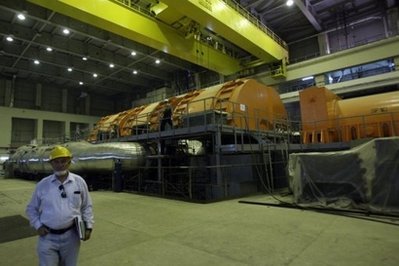IAEA: Iran Speeds Up Installation of Nuclear Equipment
إقرأ هذا الخبر بالعربية
Iran is making significant progress in expanding its nuclear program, including in opening up a potential second route to developing the bomb, a new U.N. atomic agency report showed Wednesday.
The International Atomic Energy Agency's latest quarterly update said that Tehran has accelerated the installation of advanced uranium enrichment equipment at its central Natanz plant.
It also outlined further progress at a reactor under construction at Arak, also in central Iran, which Western countries fear could provide Iran with plutonium if the fuel is reprocessed.
One Western diplomat told Agence France Presse the report "will only increase the concerns about Iran."
Highly enriched uranium and plutonium can both be used in a nuclear weapon. North Korea used plutonium in two tests in 2006 and 2009, while uranium was used in the "Little Boy" atomic bomb dropped by the U.S. on Hiroshima, Japan in 1945.
The new IAEA report, seen by AFP, said Iran has installed at Natanz almost 700 IR-2m centrifuges and/or empty centrifuge casings, compared with just 180 in February. None was operating, however.
The U.S. State Department stated that the latest U.N. report on Iran's nuclear program marks the "unfortunate milestone" of a decade of Iranian defiance of the body.
The International Atomic Energy Agency's director general issued the report Sunday, ten years after the IAEA's first on the Iranian program in June 2003.
"And in the past 10 years, Iran has brazenly ignored multiple Board of Governors' resolutions while advancing its enrichment program in blatant violation of its international obligations," State Department spokesman Patrick Ventrell said.
"As the international community stated previously in Board of Governors resolutions and statements on Iran, we're going to continue to hold Iran accountable for its international nuclear obligations," Ventrell said.
Ventrell said the United States looks forward to a meeting in June of the IAEA board, saying: "We're going to discuss the report and look how to best respond to with other members of the board."
Iran has said it intends to install around 3,000 of the new centrifuges at Natanz -- where around 13,500 of the older models are in place -- enabling it to speed up the enrichment of uranium.
The U.N. Security Council has passed numerous resolutions calling on Iran to suspend all enrichment and heavy water activities -- of the kind under development at Arak -- and has imposed four rounds of sanctions.
Last year additional unilateral U.S. and EU sanctions targeting Iran's oil exports and its financial system began to cause real problems for the Persian Gulf country's economy.
Israel, the Middle East's sole if undeclared nuclear-armed state, has refused to rule out military action against Iran, as has U.S. President Barack Obama. Iran says that its atomic activities are peaceful.
Diplomatic efforts to resolve the impasse, most recently in six-power talks with Iran in Kazakhstan in April, have failed to make concrete progress.
Despite developments at Natanz, the IAEA report noted that Iran has not started operating any new equipment at its Fordo facility, built under a mountain near the holy city of Qom.
Fordo is of more concern to the international community, since it is used to enrich uranium to fissile purities of 20 percent and Natanz mostly to five percent, technically much closer to the 90-percent level needed for a bomb.
The IAEA report showed that Iran has produced so far 324 kilos (714 pounds) of 20-percent enriched uranium, 44 kilos more than three months ago, but that 140.8 kilos have been diverted to fuel production, up from 111 kilos.
Experts say that around 250 kilos are needed for one bomb.
At the research reactor under construction at Arak, meanwhile, which Iran says will start operating in the third quarter of 2014, the IAEA said that the plant's large reactor vessel "has been received but ... yet to be installed".
But the agency also "observed that a number of other major components had yet to be installed, including the control room equipment, the refueling machine and reactor cooling pumps."
Iran had not provided the IAEA with updated design information for the IR-40 reactor at Arak since 2006, the IAEA added, saying this was "urgently required".
The IAEA is meanwhile also trying to press Iran to provide access to documents, sites and scientists involved in what it suspects were research activities, mostly in the past but possibly ongoing, towards developing the bomb.
At one of these sites, the Parchin military base near Tehran, the new IAEA report said that in addition to months of activity leveling the area that the agency wants to inspect, Iran has now covering a "significant proportion" with asphalt.
"I don't think they are doing themselves any favors," one senior official familiar with the probe said, adding that some rubble from the site had been dumped in lakes.
No primesuspect ! Let them spend more money and resources at the expense of their people . We could expect then a reaction leading to a revolution.
smart! but in North Korea they're eating grass.... and still not revolted! let's hope Farsis have more pride than N. Koreans.



